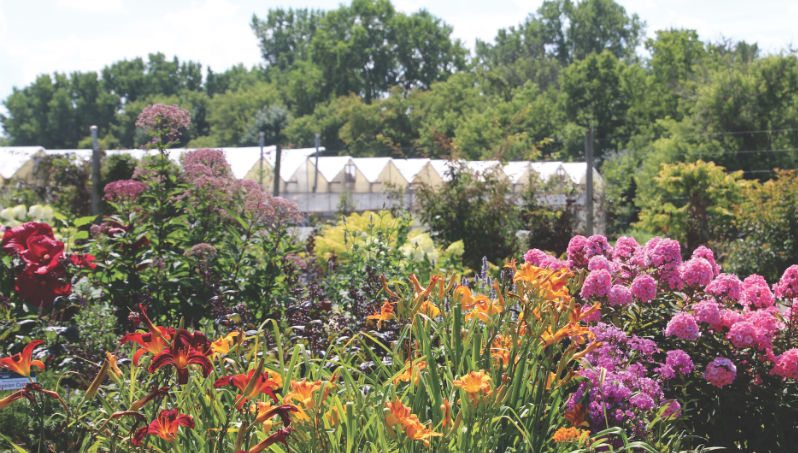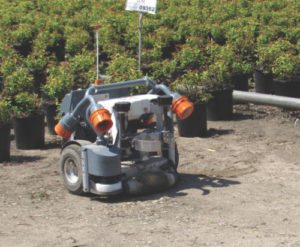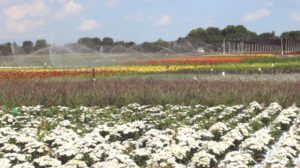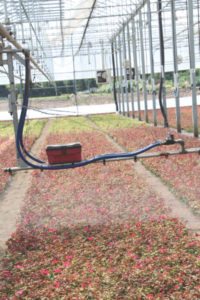
Cover Story — Growing the Family Tradition
Bailey Nurseries at a glance
Year Founded: 1905
Locations: Minnesota, Oregon, Washington and Illinois
Total Growing Space: More than 5,000 acres of greenhouse and field production
Management Team: Terri McEnaney, president and CEO; Pat Bailey, vice president – administration; John Bailey, chief financial officer
Key Leadership Group Management Team: Marc McCormack, sales and marketing director; Kevin Johnston, production manager – Midwest; Shane Brockshus, production manager – West Coast; Joe Bailey, vice president – human resources
Number of Employees: 500+ year-round employees and 600 seasonal employees
Number of Customers: 4,500 worldwide
Website: www.baileynurseries.com
Over the past 112 years, Bailey Nurseries has built its reputation by fulfilling its mission statement “to produce and distribute top-quality horticultural products and services to retail garden centers, growers and landscapers.”
John Vincent Bailey, Jr., founded the company as J.V. Bailey Nursery in 1905 on the same property where the corporate headquarters is located today in St. Paul, Minnesota. In the beginning, he grew fruits, vegetables and ornamentals for the St. Paul City Market in a rather challenging environment.
“If you are going to start a nursery back then, Minnesota was probably not the best place to do it,” says Terri McEnaney, great-granddaughter of the company’s founder and its current president. “The ground and the weather here aren’t really ideal,” she says knowingly.
But J.V. was an innovator and he persevered, McEnaney says. He took 15 acres of “unfarmable land” and developed new and better ways to grow his crops — and grow them faster — so he could be first to market. That innovative spirit is evident today as the wholesale nursery focuses on maintaining J.V.’s values of quality, service and growth by introducing new and novel products to the marketplace.
Over the years, the subsequent four generations of Baileys have consistently grown and expanded the company to meet the needs of a changing marketplace, and it has evolved from a small nursery delivering products to the farmers market into an international plant producer serving more than 4,500 customers around the globe.
Big Grower had a chance to visit with fourth- generation family member Terri McEnaney; Alec Charais, marketing and communications manager; and Terri’s son, Ryan, who is the company’s public relations and communications specialist, to find out more about how the company has gotten to where it is today and where it is headed in the future.
The Fourth Generation
Terri McEnaney became president of Bailey Nurseries in 2001. Along with six other fourth- generation Bailey family members, she is responsible for carrying on the family tradition of growing the company.
While Terri grew up around the business and worked at the nursery while she was in high school, when she went to college she got a business degree with an emphasis on accounting. Upon graduation she went to work in the corporate world at 3M for eight years.

Working at a large multinational conglomerate, McEnaney says, provided her with a great foundation for the business world that she would eventually apply to the horticulture industry.
McEnaney returned to the company in 1991 with a whole new perspective on the family business.
“I’ve always really tried to focus on the business side of things — the strategy of the business,” she says. “One thing I’ve learned over the years is that I don’t need to know everything.”
That’s why she enjoys and really values traveling with others from the company and interacting with customers to hear directly from them about the types of challenges — and opportunities — they are facing.
She is also an active participant in several different industry organizations and just finished her term serving on the board of directors of AmericanHort. She says the interaction from those meetings is incredibly invaluable.
“I try to take everything I’ve learned from those types of meetings, bring it back to our organization and then ask, ‘What does that mean to us? What is happening in the marketplace? How are we going to change [because of those things]?’” she says. “Because if we don’t change, we become irrelevant.”
“There are so many different ways that we can connect with each other. It helps everybody become better business people,” McEnaney adds.
She says one of the reasons for the company’s success is that each generation of the Bailey family has always focused on the company’s long term vision. Whether that involves investing in new technology, starting a new breeding program, developing innovative brands or finding new ways connect with consumers, McEnaney says, “We have to have the voice of our customer in mind as we make our [internal] decisions.”

“As we are looking forward, part of our philosophy is making sure we run a strong business so that you can be there in the future, but you have to be able to adapt to what your customer is now and what they will become in the future,” comments Ryan McEnaney, a member of the fifth generation of Baileys.
“One of the things, as a family-owned business, that we think we are really good at is relationships and connecting with our partners at a personal level,” adds Alec Charais. “That has allowed us to really understand our customers’ needs really well. We take pride in that direct interaction. You don’t ever want to lose that family aspect of the business.”
Building Its Brand
One area Bailey Nurseries has really focused on in recent years and has helped the company advance is the development of its consumer branded products.
In 2003-2004, Bailey Nurseries introduced its Endless Summer Hydrangeas, the industry’s first collection of Hydrangea macrophylla. Shortly after that, the company’s Easy Elegance Rose Collection debuted. The First Editions brand of easy-to-maintain shrubs and trees was launched in 2008.

These branded products are just a portion of the more than 1,500 plant varieties that are available to customers as bare root, finished or liner products.
“Branding for us started with a great product first. That is the foundation of any good brand,” Charais remarks. “Otherwise it is simply just packaging.”
“To be a successful national brand, you really need to rely on partnerships,” Charais says. So, when Endless Summer launched, Bailey Nurseries adopted a licensing model for growers and retailers who are producing the plants and getting distribution of the products through the supply chain to the consumer.
He says the licensing model has helped the brands grow “because you have more marketing funds built into the cost of goods, which has allowed us to create that demand and that pull-through experience to help our retailers capture that traffic.”
By building a network of growers in each region, it made it much easier to get the product to different parts of the country in a timely fashion. Charais says the grower network continues to expand as more and more growers recognize the benefits they can take advantage of by growing the branded products.
Reach Out and Touch the Consumer
Another one of the keys to growing the company’s brands is how it is touching today’s (and tomorrow’s) consumers.
“We want the consumer to have a great experience with our product,” Charais says. “We know we need to always be changing how we approach marketing our brands to make an impression [on the consumer]. At the end of the day, good promotion and good advertising mean you go where the consumer is and you speak with them on their level.”
“People are going to gravitate to those [mediums] where they can get the quickest, most reliable answer. That is our goal and our strategy from a brand perspective,” Charais adds.
When the Endless Summer Hydrangea Collection launched, it was one of the first plant brands to have its own consumer-facing website. And with the advent of social media and the changes in demographics of today’s consumers as younger people enter into the category, Bailey Nurseries is trying to reach potential users in new and novel ways including text messaging, interactive online advice columns, a Pandora Internet radio station, #hashtag campaigns and even at major sporting events like the Super Bowl just to name a few.

Traditional marketing techniques still play an important role too. It just depends on the customer. “We are finding and communicating with consumers wherever they are most comfortable,” Ryan McEnaney adds.
“The opportunity is there. We need to listen, and now we have the tools to do that. They are telling us what they want and what they will do,” Ryan remarks.
Never Forget the Beauty
When J.V. Bailey founded his company in 1905, things were done at a much slower pace, but being the innovator that he was, Bailey found a better (and faster) way to do things. In fact, he was the first person to deliver his products to the St. Paul market in a motorized vehicle!
And things never slowed down. Terri, Ryan and Alec all agree it is really easy to get caught up in the day-to-day business of growing and selling plants. Interacting with growers, retailers and consumers is a vital cog in the company’s success but they never lose sight of what benefits plants have to offer to the public — no matter what demographic they are in.
Introducing new plants, growing them efficiently and profitably and making that consumer connection are all very rewarding. Plants are often taken for granted but Terri says we need to remind people how great they are and what they have to offer.
“I think this is one of the more exciting times to be in our industry,” Charais says.
“At the end of the day, our products bring beauty to the world and how amazing is that?” Charais asks. “And we are doing it in ways now that are much more exciting than ever before.”
“We just need to continue to connect at the consumer level and respond to them appropriately so they can use our beautiful product,” Charais declares.





 Video Library
Video Library 




















